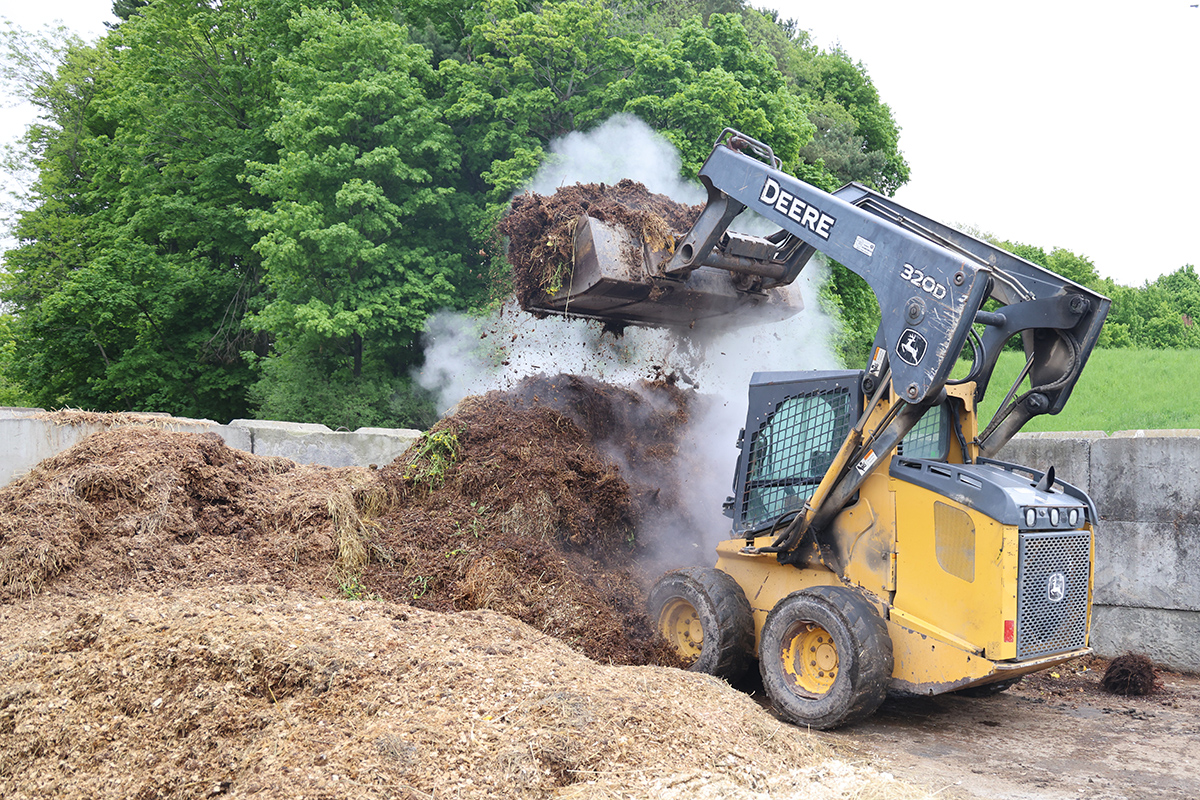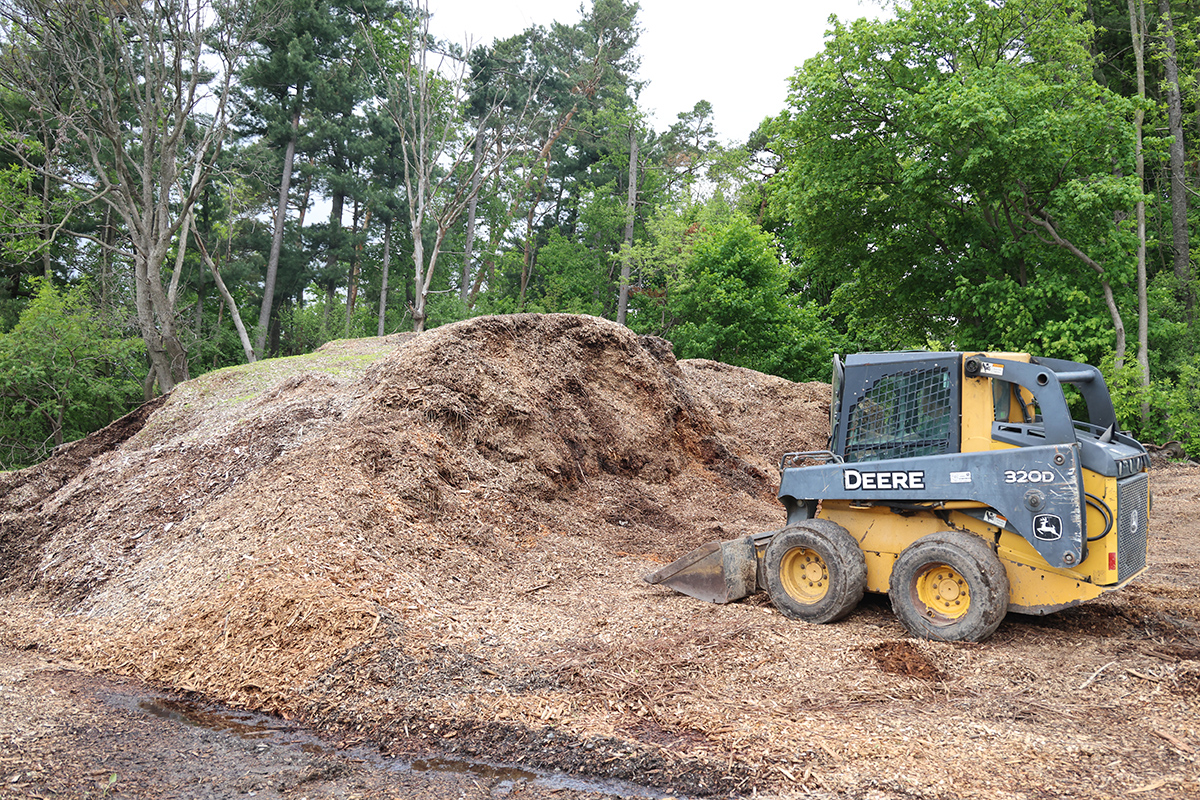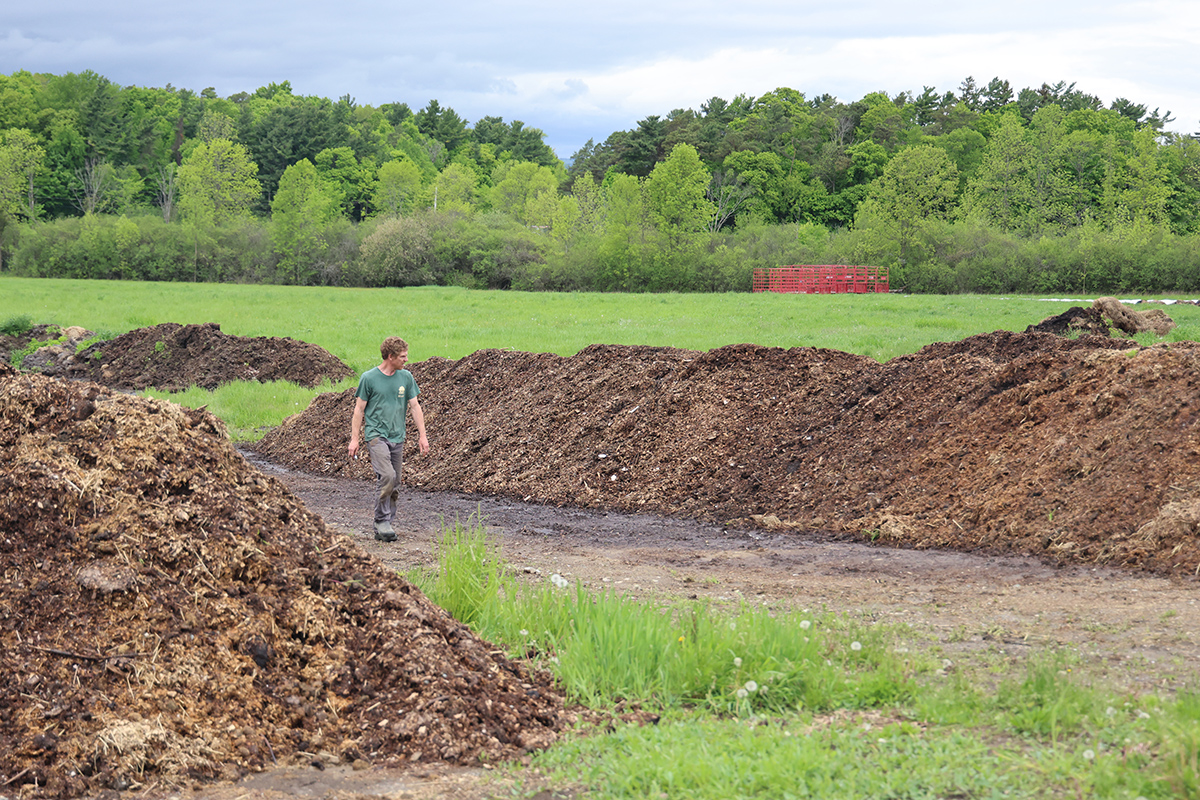I love this! Compost is one of the most underestimated treasures around, and figuring out the mysteries of making great compost is time well spent.
Creating a Perfect (De)Composition
“Compost happens,” says the old bumper sticker. Organic matter simply decomposes. As Market Garden Manager Josh Carter says, “The magic is you could do nothing and still make compost.”
But Josh doesn’t do nothing. And this year, when it comes to compost, he plans to do more. He’s making changes to yield a biologically and organically rich additive to the 7-acre Market Garden. His learning might help you improve your own composting, too.

There’s a host of benefits to composting that many of us know. It builds soils, mulches and moistens, creates healthier, higher yielding gardens, and by keeping food scraps out of landfills, can help limit greenhouse gas emissions. Recognizing this, Vermont banned food scraps in trash in 2020, hoping to accelerate composting state-wide.
But for Josh, food scraps are the easy part. “It’s really easy to make all the food stuff that’s coming off plates at the Inn or its kitchen disappear in the composting process,” he says. “What's harder is making a refined professional-grade compost that is super fertile and finished.”
It starts with your ingredients, or feedstocks. For the average household, that might be food scraps, lawn/landscape clippings, and leaves. Josh composts all that, plus wood chips (lots of wood chips!), biochar, and animal manure/bedding from multiple locations: the Children’s Farmyard; a neighboring horse farm; and the production chicken coop. (The dairy cow manure doesn’t typically feed into Josh’s garden compost. The dairy has its own compost system, and the product is applied to hay fields.)
Our Compost Ingredients
Wood Chips
Horse Manure/Bedding
Leaves
Farmyard Manure/Bedding
Chicken Bedding
Biochar
Bedding hay
Landscape/Garden residue
Microbes break down those ingredients for carbon and nitrogen. Carbon is the “energy” for the microbes and nitrogen builds proteins that keep the microbes active. (Most composting guides call the carbon components “brown” and the nitrogen ones “green”.) You can adjust that C:N ratio for different final compost products depending on your goals, but getting it right is tricky.
Right now, we’re not quite getting it right. “We have too much carbon in our piles from all the woodchips,” Josh explains, “and our piles are basically stalling out.” That means the microbes aren’t working efficiently and we end up with coarse, carbon-heavy compost. When applied to crops, the compost ties up the microbes in the soil, too. And, as those microbes try to process the compost, they can actually compete with plants for nitrogen.
But changes are afoot. First, Josh is making some basic adjustments to dial down the carbon, like adding aged woodchips to the compost, not fresh ones. To do that, he’s pulling from the back of a considerable pile, not the front. “It’s funny that I never thought of this before,” he chuckles, “but these wood chips could be 20 years old! They’re already partially decomposed, and they already have microbial populations.” This makes further decomposition easier.

He’s also managing the manure and bedding from the horse farm differently. Because it arrives weekly, and in such volume, it’s really the backbone of our system. “We used to stockpile it in one big pile,” Josh explains. “Now I’ve windrowed it, because the windrow is a form of active composting.”

This spring, Josh also had some of the feedstocks analyzed to better understand their chemical makeup. (Good news: the aged wood chips have a neutral impact on compost carbon.) Based on all the tests, a consultant has developed a few compost “recipes” for us. Josh says, “Intentionally keeping all our ingredients separate and then mixing them based on these recipes is how we're going to move forward.”
At the other end of the process, he’s also screening out the biggest wood chips with a rented mechanical sifter. “Unsifted, finished compost is kind of sticky and clumpy,” he explains. “Sifted compost is a finer material that’s just much easier to shovel and scoop.” And again, with less carbon in it, the compost is easier for soil microbes to process.

What’s motivating Josh to do all this is a vision of a no-till, mulch-composting growing system. He has lots of beds in mind where he wants to spread finished compost several inches thick, then seed and plant right into it. “The compost is part mulch and part growing media,” says Josh. “The plants will eventually get to the soil below the compost as they grow,” he continues, “but the compost is acting both as a mulch, and as a vibrant, ecological soil mix.”
He’s doing the work now so that he can fully launch this approach next year. Compost may happen, but it does take time and careful management for the greenest results.
Comments
Loved the piece! I love nearby and have a 3 year old composting enthusiast who would die for a composting-themed educational activity, if you're ever looking for an audience. ;)
I suggest that Josh consider propagating a small grove of comfrey plants (beautiful flowers) to incorporate into the compost operation. Comfrey is a mammoth weed which has the advantage of having an extremely deep tap root, accessing nutritional constituents not available when only using plants with shallow roots (conventional compost feed stock). I learned about this from staff at the research department of the Edinburgh Botanical Gardens in Scotland. Comfrey leaves are periodically harvested (restricted to about 33 % each time), comminuted, added to water in a simple still, and "brewed" to a potent "tea," used directly to fertilize crops, with the spent stock added to the regular compost operation. Building a still large enough for a 1,000 Sq. Ft. vegetable garden, fed by two comfrey plants, involves modifying a heavy duty, 50 gal., residential garbage barrel with about $15 of plastic plumbing parts (perforated manifold, gaskets, and spigot); takes about half an hour to fabricate. If Josh wants more info and pictures, let me know. When I stayed at the Inn last October, I gave myself a tour of Josh's domain (nobody around) and also observed that what I assumed to be large, plastic, cattle watering devices in the pastures might be amenable to modification into larger capacity stills for a more industrial application.
